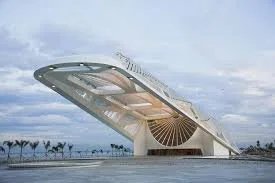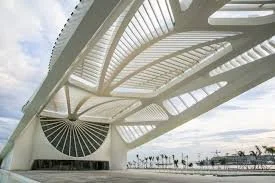Rio de Janeiro is a city that is known for its beaches, Carnival celebration and Christ the Redeemer statue that people flock to from around the world. As Brazil continues to move into the 21st century the Museum of Tomorrow aims to tie together Rio’s rich history while being able to push the boundaries of what is possible.
The Museum of Tomorrow was designed by Santiago Calatrava, a Spanish & Swiss Architect, who has designed hundreds of buildings globally over his 30+ year career. The museum opened in 2016 and is roughly 135,000 square feet and is located on the Maua Pier with the height of the building limited to 18 meters, protecting the view of the Sao Bento Monstery that is a UNESCO World Heritage Site.
According to Architect Magazine, the museum is focused on answering 5 key questions:
Where did we come from?
Who are we?
Where are we?
Where are we going?
How do we want to live together over the next 50 years?
These questions allow the museum to create exhibits that address issues such as population growth, consumption patterns, climate change, distribution of wealth and biodiversity. These issues all have an impact on the planet and have different impacts on different populations and groups globally. All of the exhibits intend to keep the conversation going of how climate change is impacting people and what the future is going to look like.
One of the most interesting parts of this structure is the nearly 75 meter long overhang that hangs over the bay resembling more or less the mouth of a whale that gives the allusion the the building is ‘floating’. This futuristic building has a lot of sustainability initiatives built into it such as incorporating natural energy with solar planers that are adjusted during the day to optimize the angle of the suns rays and light sources with large windows in the building to utilize as much natural sun light as possible. With the solar panels that are utilized the museum is able to save up to 50% energy as compared to conventional buildings.
The museum was certified LEED Gold under the BD+C: New Construction in 2016 with issues related to water management, renewable materials and energy efficiency being some of the main focal points with the building design. Museum of Tomorrow was able to achieve 18 out of a possible 26 points in the Sustainable Sites category and 8 out of 10 points in the Water Efficiency category. Both of these categories where focus points for the designers and architects of the site itself. Some of the Regional Priority Credits that where awarded include: Optimize Energy Performance, Water Efficient Landscaping, Innovative Wastewater Technologies and Water Use Reduction. These 4 credits show the energy and water efficiency measures that where taken to future-proof the building for decades to come.
Interested in Learning More?
Architecture Magazine Article: https://www.architectmagazine.com/project-gallery/the-museum-of-tomorrow_o
Arch Daily Article: https://www.archdaily.com/785442/museum-of-tomorrow-santiago-calatrava
USGBC Scorecard: https://www.usgbc.org/projects/museu-do-amanha


